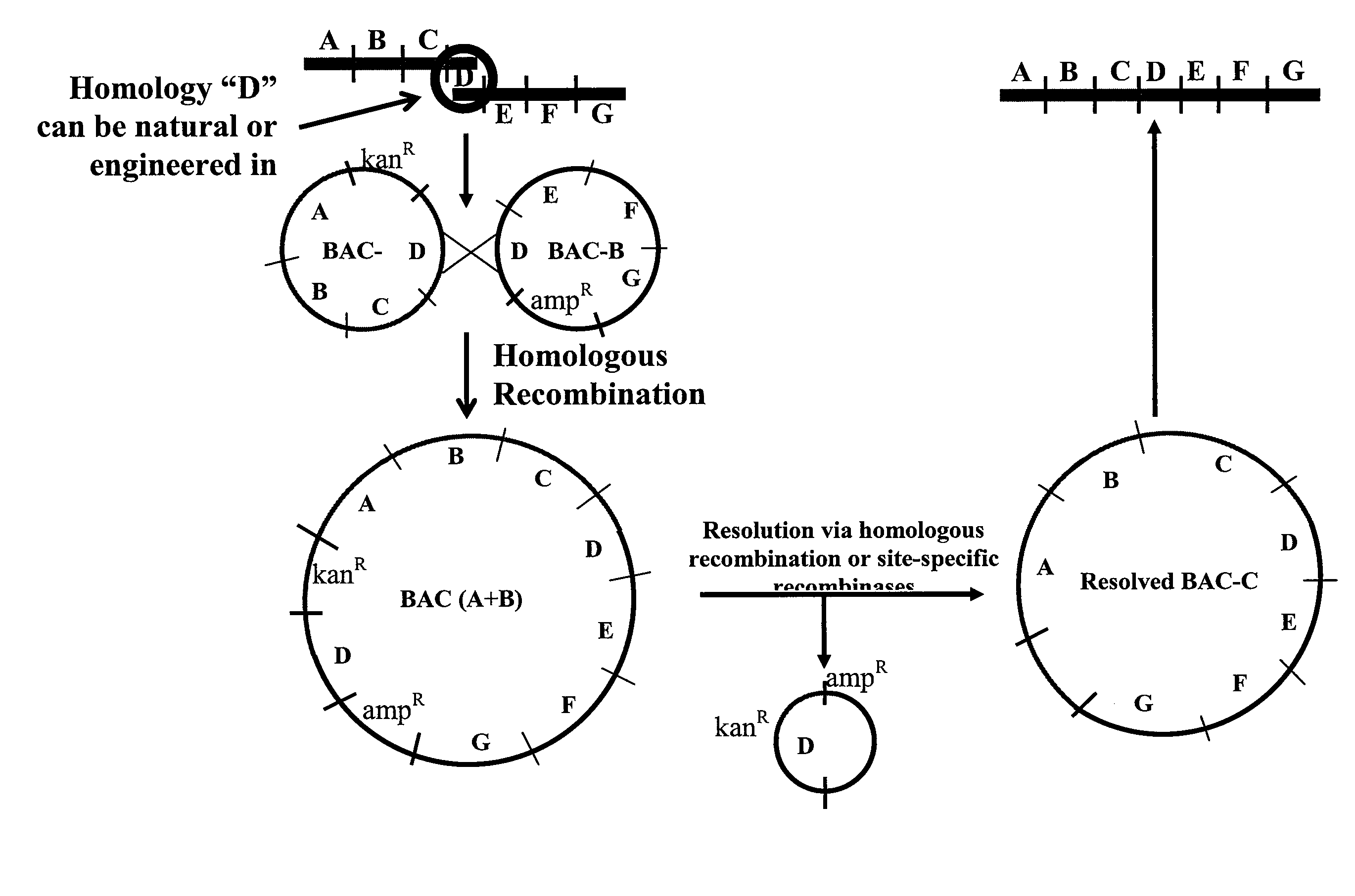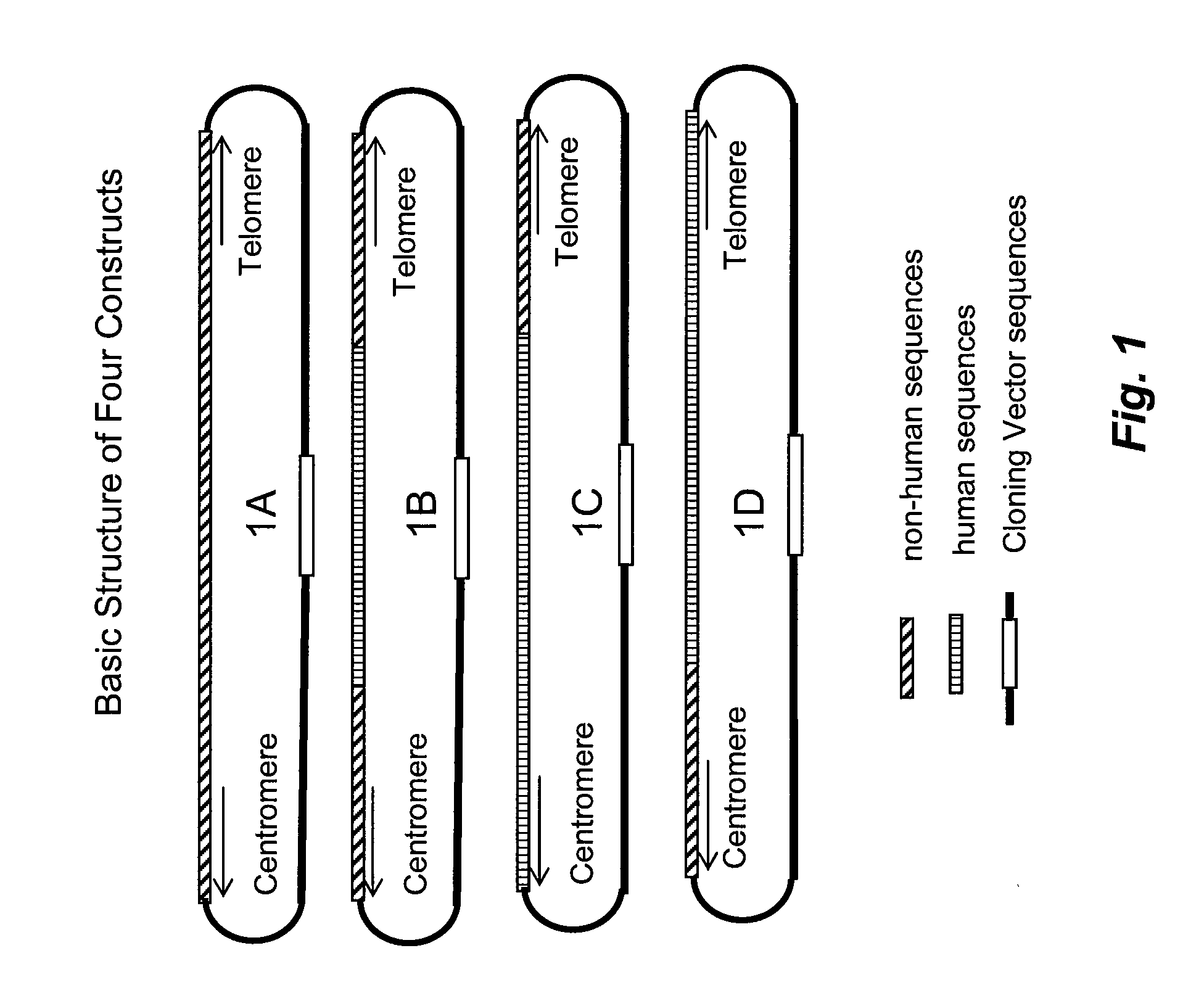Methods for sequential replacement of targeted region by homologous recombination
a technology of homologous recombination and target region, which is applied in the field of gene targeting by homologous recombination, can solve the problems of affecting the study of biological systems in vivo, e.g., over 50 kb, and is difficult to replace large dna sequences, so as to achieve the effect of convenient us
- Summary
- Abstract
- Description
- Claims
- Application Information
AI Technical Summary
Benefits of technology
Problems solved by technology
Method used
Image
Examples
example 1
DNA CONSTRUCTS
[0112]To employ the approach of the present methods, four types of DNA constructs may be used. They may be chosen based on the specific needs of the gene replacement desired.
[0113]The first type of construct (1A in FIG. 1) has 1) DNA sequences homologous to endogenous DNA sequences, 2) one or more sequences that supply selection markers, and 3) cloning vector DNA sequences.
[0114]One may generate a DNA construct carrying an endogenous flanking sequence having genes for GFP and G418 resistance, cloned in a BAC vector, such as the pBeloBAC11 vector.
[0115]The second type of DNA construct (1B in FIG. 1) has 1) non-endogenous DNA sequences to replace endogenous target DNA sequences, 2) flanking DNA sequences homologous to endogenous sequences in the cell to be transformed or transfected, 3) sequences for one or more selection markers, and 4) cloning vector DNA sequences. In this way one can generate a DNA construct cloned in a BAC vector, having genes for RFP and Hygromycin ...
example 2
HOMOLOGOUS RECOMBINATION OF BACs IN E. COLI
[0118]The DNA constructs of the invention may be designed and cloned in vectors such as BACs. Homologous recombination in E. coli can be used to construct BACs with larger inserts of DNA than is represented by the average size of inserts of currently available BAC libraries. Such larger inserts can comprise DNA representing a human locus, or a portion thereof.
[0119]A BAC vector is based on the F-factor found in E. coli. The F-factor and the BAC vector derived from it are maintained as low copy plasmids, generally found as one or two copies per cell depending upon its life cycle. Both F-factor and BAC vector show the fi+ phenotype that excludes an additional copy of the plasmid in the cell. By this mechanism, when E. coli already carries and maintains one BAC, and then an additional BAC is introduced into the E. coli, the cell maintains only one BAC, either the BAC previously existing in the cell or the external BAC newly introduced. This f...
example 3
ISOLATION OF BAGS AND INTRODUCTION INTO EUKARYOTIC CELLS
[0124]In preparation for introduction into homologous recombination competent cells, such as ES cells, expression cassettes can be recombined onto the DNA constructs, e.g., BACs. For example, mammalian cassettes carry genes with required regulatory elements such as promoters, enhancers and poly-adenylation sites for expression of the genes in mammalian cells, such as mouse ES cells. The genes on the cassette include selectable markers used to select and screen for cells into which the BAC has been introduced and homologously recombined.
[0125]For introduction into homologous recombination competent eukaryotic cells, BAC DNA is purified from E. coli and the E. coli genomic DNA by methods known in the art such as the alkaline lysis method, commercial DNA purification kits, CsCl density gradient, sucrose gradient, or agarose gel electrophoresis, which may be followed by treatment with agarase. The purified DNA may then be linearize...
PUM
| Property | Measurement | Unit |
|---|---|---|
| Digital information | aaaaa | aaaaa |
| Length | aaaaa | aaaaa |
| Electrical resistance | aaaaa | aaaaa |
Abstract
Description
Claims
Application Information
 Login to View More
Login to View More - R&D
- Intellectual Property
- Life Sciences
- Materials
- Tech Scout
- Unparalleled Data Quality
- Higher Quality Content
- 60% Fewer Hallucinations
Browse by: Latest US Patents, China's latest patents, Technical Efficacy Thesaurus, Application Domain, Technology Topic, Popular Technical Reports.
© 2025 PatSnap. All rights reserved.Legal|Privacy policy|Modern Slavery Act Transparency Statement|Sitemap|About US| Contact US: help@patsnap.com



